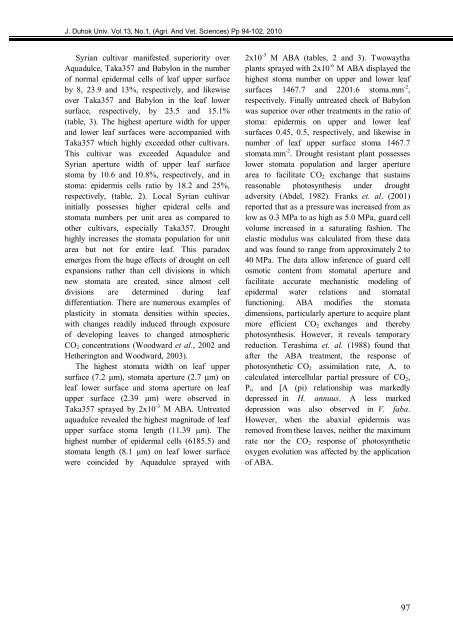The Influence Of Priming Two Cucumber Cultivar Seeds
The Influence Of Priming Two Cucumber Cultivar Seeds
The Influence Of Priming Two Cucumber Cultivar Seeds
Create successful ePaper yourself
Turn your PDF publications into a flip-book with our unique Google optimized e-Paper software.
J. Duhok Univ. Vol.13, No.1, (Agri. And Vet. Sciences) Pp 94-102, 2010<br />
Syrian cultivar manifested superiority over<br />
Aquadulce, Taka357 and Babylon in the number<br />
of normal epidermal cells of leaf upper surface<br />
by 8, 23.9 and 13%, respectively, and likewise<br />
over Taka357 and Babylon in the leaf lower<br />
surface, respectively, by 23.5 and 15.1%<br />
(table, 3). <strong>The</strong> highest aperture width for upper<br />
and lower leaf surfaces were accompanied with<br />
Taka357 which highly exceeded other cultivars.<br />
This cultivar was exceeded Aquadulce and<br />
Syrian aperture width of upper leaf surface<br />
stoma by 10.6 and 10.8%, respectively, and in<br />
stoma: epidermis cells ratio by 18.2 and 25%,<br />
respectively, (table, 2). Local Syrian cultivar<br />
initially possesses higher epideral cells and<br />
stomata numbers per unit area as compared to<br />
other cultivars, especially Taka357. Drought<br />
highly increases the stomata population for unit<br />
area but not for entire leaf. This paradox<br />
emerges from the huge effects of drought on cell<br />
expansions rather than cell divisions in which<br />
new stomata are created, since almost cell<br />
divisions are determined during leaf<br />
differentiation. <strong>The</strong>re are numerous examples of<br />
plasticity in stomata densities within species,<br />
with changes readily induced through exposure<br />
of developing leaves to changed atmospheric<br />
CO2 concentrations (Woodward et al., 2002 and<br />
Hetherington and Woodward, 2003).<br />
<strong>The</strong> highest stomata width on leaf upper<br />
surface (7.2 μm), stomata aperture (2.7 μm) on<br />
leaf lower surface and stoma aperture on leaf<br />
upper surface (2.39 μm) were observed in<br />
Taka357 sprayed by 2x10 -3 M ABA. Untreated<br />
aquadulce revealed the highest magnitude of leaf<br />
upper surface stoma length (11.39 μm). <strong>The</strong><br />
highest number of epidermal cells (6185.5) and<br />
stomata length (8.1 μm) on leaf lower surface<br />
were coincided by Aquadulce sprayed with<br />
2x10 -3 M ABA (tables, 2 and 3). <strong>Two</strong>waytha<br />
plants sprayed with 2x10 -6 M ABA displayed the<br />
highest stoma number on upper and lower leaf<br />
surfaces 1467.7 and 2201.6 stoma.mm -2 ,<br />
respectively. Finally untreated check of Babylon<br />
was superior over other treatments in the ratio of<br />
stoma: epidermis on upper and lower leaf<br />
surfaces 0.45, 0.5, respectively, and likewise in<br />
number of leaf upper surface stoma 1467.7<br />
stomata.mm -2 . Drought resistant plant possesses<br />
lower stomata population and larger aperture<br />
area to facilitate CO2 exchange that sustains<br />
reasonable photosynthesis under drought<br />
adversity (Abdel, 1982). Franks et. al. (2001)<br />
reported that as a pressure was increased from as<br />
low as 0.3 MPa to as high as 5.0 MPa, guard cell<br />
volume increased in a saturating fashion. <strong>The</strong><br />
elastic modulus was calculated from these data<br />
and was found to range from approximately 2 to<br />
40 MPa. <strong>The</strong> data allow inference of guard cell<br />
osmotic content from stomatal aperture and<br />
facilitate accurate mechanistic modeling of<br />
epidermal water relations and stomatal<br />
functioning. ABA modifies the stomata<br />
dimensions, particularly aperture to acquire plant<br />
more efficient CO2 exchanges and thereby<br />
photosynthesis. However, it reveals temporary<br />
reduction. Terashima et. al. (1988) found that<br />
after the ABA treatment, the response of<br />
photosynthetic CO2 assimilation rate, A, to<br />
calculated intercellular partial pressure of CO2,<br />
Pi, and [A (pi) relationship was markedly<br />
depressed in H. annuus. A less marked<br />
depression was also observed in V. faba.<br />
However, when the abaxial epidermis was<br />
removed from these leaves, neither the maximum<br />
rate nor the CO2 response of photosynthetic<br />
oxygen evolution was affected by the application<br />
of ABA.<br />
49



